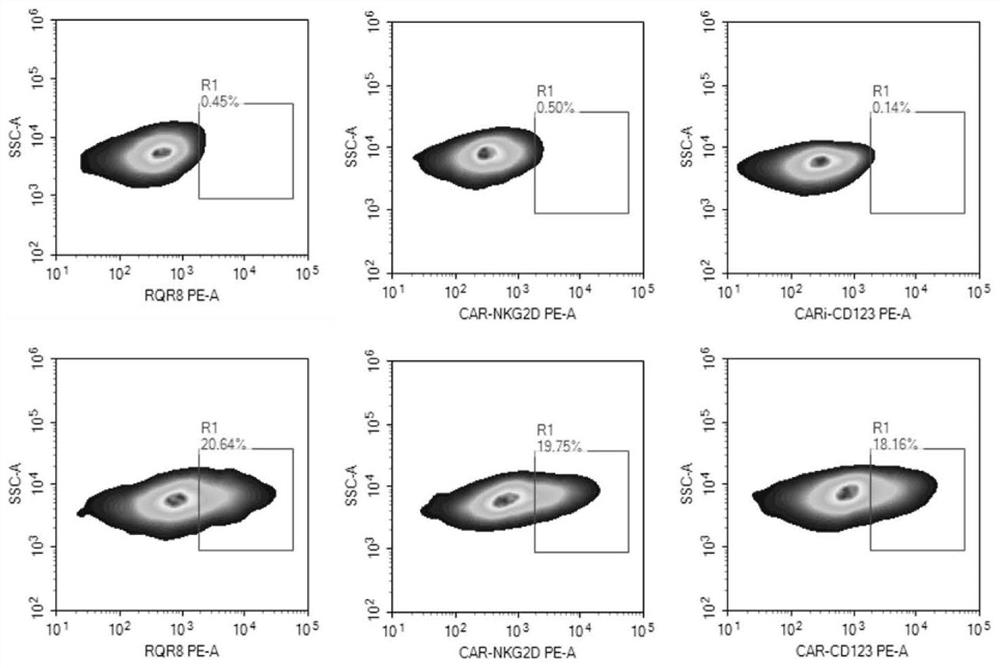Bispecific chimeric antigen receptor targeting CD123 and NKG2D ligands and application of bispecific chimeric antigen receptor
A chimeric antigen receptor and bispecific technology, applied in the field of tumor biological immunotherapy, can solve the problems of weak targeting specificity, limited proliferation and killing ability, and low anti-tumor efficiency, so as to improve prognosis and increase specificity. Sexually lethal effects
- Summary
- Abstract
- Description
- Claims
- Application Information
AI Technical Summary
Problems solved by technology
Method used
Image
Examples
Embodiment 1
[0126] Example 1 Construction of an expression plasmid targeting bispecific chimeric antigen receptors targeting human CD123 and human NKG2DL
[0127]This example provides a bispecific chimeric antigen receptor that simultaneously expresses anti-human CD123 scFv (CSL362-humanized mouse anti-CD123 mAb 7G3) and the extracellular domain of human NKG2D. In this example, the two antigen-binding domains are combined in parallel. Such as figure 1 As shown, the structure of the bispecific chimeric antigen receptor provided in this example includes: the first signal peptide domain (human CD8α, CD8αSP) connected in sequence, the first antigen binding domain (anti-human CD123 targeting human CD123 scFv, Anti-CD123 scFv), the first hinge domain (human CD8α hinge region, CD8αH), the first transmembrane domain (human CD28 transmembrane region, CD28 TM), the first co-stimulatory signal domain (human CD28 Stimulatory signal domain, CD28 CS), the first intracellular signaling domain (human C...
Embodiment 2
[0141] The preparation of embodiment 2 lentiviruses
[0142] 1. Virus packaging: The expression plasmid of the bispecific chimeric antigen receptor targeting human CD123 and human NKG2DL constructed in Example 1, and the viral packaging plasmid (pLP1, pLP2, VSVG) were 7:5:5: The ratio of 3 (total 24ug) was co-incubated with Lipofilter (Hanheng Company) and then co-transfected into 293T cells (100mm culture dish, confluence 50%-70%). For specific transfection procedures, please refer to the instructions of Hanbio LipoFiter Transfection Reagent. The DMEM complete medium was replaced 6 h after transfection.
[0143] 2. Virus harvest and concentration: Collect the cell culture supernatant at 48 hours and 72 hours respectively, centrifuge at 3000 rpm at 4°C for 15 minutes, and filter the supernatant through a 0.45 μm filter membrane. Finally, ultracentrifuge at 25,000 rpm for 2 to 3 hours at 4° C., discard the supernatant, and resuspend the pellet with fresh DMEM medium to obtain...
Embodiment 3
[0144] Example 3 Preparation of bispecific chimeric antigen receptor T cells (named 123NL-CART) targeting human CD123 and human NKG2DL
[0145] Step 1 Obtain human peripheral blood T cells:
[0146] 1. Collect about 20ml of human peripheral fresh blood with a vacuum blood collection tube containing heparin;
[0147] 2. Take a 50ml centrifuge tube, draw 20ml of Ficoll lymphocyte separation solution into the centrifuge tube, tilt the tube, and slowly add the collected peripheral blood to the upper layer of Ficoll along the tube wall at about 1cm above the Ficoll liquid level. Centrifuge at 500g for 25min at 4°C.
[0148] 3. After centrifugation, it is divided into four layers from the bottom of the tube to the liquid surface, which are red blood cell and granulocyte layer, stratified liquid layer, mononuclear cell layer (ie, buffy coat layer), and plasma layer. Use a pipette to directly suck up the upper layer of plasma, gently suck out the mononuclear cell layer, put it into ...
PUM
 Login to View More
Login to View More Abstract
Description
Claims
Application Information
 Login to View More
Login to View More - R&D
- Intellectual Property
- Life Sciences
- Materials
- Tech Scout
- Unparalleled Data Quality
- Higher Quality Content
- 60% Fewer Hallucinations
Browse by: Latest US Patents, China's latest patents, Technical Efficacy Thesaurus, Application Domain, Technology Topic, Popular Technical Reports.
© 2025 PatSnap. All rights reserved.Legal|Privacy policy|Modern Slavery Act Transparency Statement|Sitemap|About US| Contact US: help@patsnap.com



